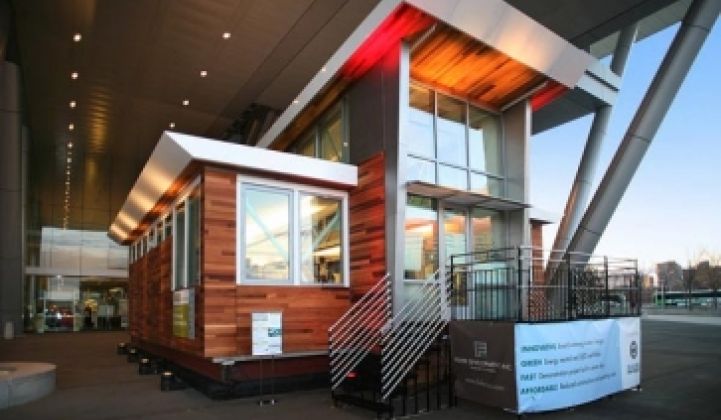The next hip thing – maybe – is going to be the building in a box.
Project Frog, which specializes in small commercial buildings and schools, will build a new warming hut at Crissy Field in San Francisco using its Lego-like building technique, said Mark Miller, Frog's CEO, at the Green Building Summit last week. Meanwhile, modular home builder Zeta Communities (see profile from last year here) is going to take the wraps off its first demo home in Oakland soon. Zeta is also building a 30-unit apartment complex in Berkeley.
Although Frog and Zeta focus on different parts of the market, both share similar underlying technologies. Rather than build homes out of boards, cement blocks and other materials toted out to a job site, the companies produce walls and even complete rooms in factories. These components, or sometimes entire sections of buildings, then get hauled to a site by large trucks. Building in factories allows the builders to get tighter seals on joints and walls. This keeps heat in and mold out. The Zeta beta, in fact, is twice as air tight as the goal set by the company, according to John Straube of Building Science Corporation, which is conducting tests on the Zeta home.
Factory homes also more readily exploit software simulations and computer data in the building process, which in turn leads to greater energy efficiency. With simulations, a builder and/or architect can try to maximize daylight and passive cooling techniques to lower power bills and maximize output on solar panels. Building operations – lights, air conditioners, heaters, etc. – consume about 39 percent of the energy in America and construction consumes another 12 percent. A building at the Kawaikini School Frog is erecting in Hawaii will actually generate a net 1.5 kilowatt hours per square foot a year. (The picture is a demo building erected by Frog.)
California's school districts spend $1 billion on energy a year, Miller said.
Construction can also take far less time and cost less. The Zeta home, which measures about 1,500 square feet, costs about $258,000 or $165 a square foot. The company is confident that it can build homes in the Bay Area or small commercial buildings for $150 to $250 a square foot, not including land, said CEO Naomi Porat. A home or building built to the same standards would cost around $250 to $300 a square foot. Even one built to lesser, shabbier standards in the area would cost $150 a square foot or so.
When Zeta gets to manufacturing scale, it will be able to build homes for less for other parts of the country.
"Through factory built housing we are going to be able to drive down prices," she said.
Zeta also includes a ventilation/heater control unit called ZTherm in every home. ZTherm senses temperatures and can click on fans to bring in cool evening air or warm outside air, depending on what would be appropriate and what the homeowner has selected. In a sense, it provides the benefits of smart grid technology without having to wait for a smart meter by allowing the house to rely more on passive cooling rather than mechanical air conditioners or heaters. (Zeta is one of three building companies incubated by entrepreneur Marc Porat – he was also instrumental in CalStar Products and Serious Materials.)
An added bonus there's the potential customer appeal. To a lot of Americans, factory homes mean one thing: trailers. But modular construction has been popular for upscale condos in Europe and Japan for a number of years. The new wave of factory homes are also generally designed by architects and try to emphasize natural light and modern design. (The existing Crissy Field warming hut is already a social gathering spot for people who listen to way too much NPR.) Various state agencies and professional groups are also touting standards that would require homes to become net zero energy structures by 2020 and commercial buildings by 2030: Modular construction techniques invariably will play a role in meeting those goals.
Green building principles in general also tend to increase the value of buildings and provide other benefits. Adobe Systems retrofitted its Silicon Valley headquarters and found that it reduced energy by 37 percent and water by 41 percent, according to statistics from Dan Geiger, executive director of the U.S. Green Building Council, Northern California Chapter. With utility rebates, the return on investment took less than a year. CB Richard Ellis also found that vacancy rates for LEED-certified buildings in San Francisco were lower than non-LEED space.
Of course, building is not the most stable industry. Michelle Kaufmann Designs, which built 40 modular homes and was one of the premier companies in this space, called it quits a few weeks ago, a victim of the tough economic times.



